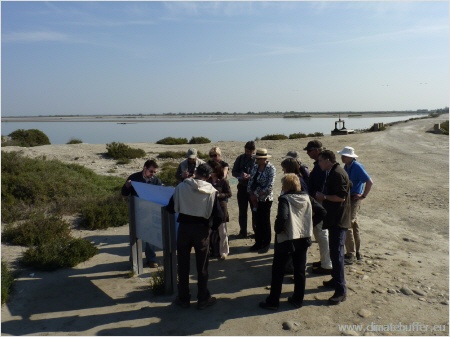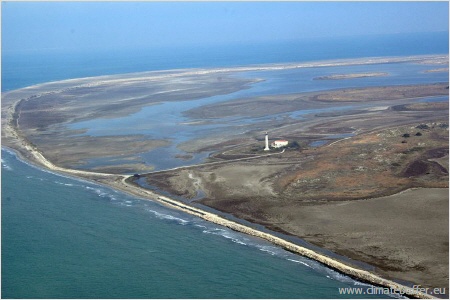Coastline of the Carmague
Purpose of the Meeting
The study visit at the Camargue took place between 18th and 21st April 2011. The group learned about the impacts of climate change on the management of coastal areas. That included the issues 'management of the coastline including the climate change', 'management of the invasive species' and 'monitoring of the climate change impacts'.

The Camargue Region and the Visited Sites
(Map: Conservatoire du Littoral)

The Study Group at Beauduc
(Photo: Celine Damery)
Description of the Area
The Carmague is a wetland of international importance (Ramsar, Man and Biosphere Reserve) and it is the largest wetland of France. The Camargue is the largest biodiversity hotspots between Barcelona and Genoa (145,000 ha). Dating back of about 7,000 years, the actual Camargue delta covers, from West to East, a length of 60 km of sandy coastline, and represents, from north to south, a transition zone between freshwater and saltwater, strongly depending of the extreme conditions of the Mediterranean climate (irregular rainfall with sometimes a high intensity, strong summer hydric deficit, ubiquitous winds). Located at the end of the Rhone Valley and on the shores of the Mediterranean Sea, the Camargue is located on a major bird migration route.
Vast plains, potentially rich and fertile, the Camargue has prompted the development of human activities since the early XIXth century (breeding of bulls and horses, rice growing, salt exploitation...). However, the frequent floods of the Rhone or the sea, have required the creation of dikes surrounding the delta and the construction of a vast network of pumping, irrigation and drainage conditions for a control of inputs and outflows of freshwater and saltwater.
The designation of the Camargue as a Wetland of International Importance (Ramsar Convention) is justified by a big wealth and a diversity of habitats of patrimonial interest: 40 habitats recognized at European level (including 7 priority); 2 habitats of national interest; 3 habitats of regional interest. The most characteristic habitats are mainly related to marine-lagoonal area of the Camargue: sansouires (low vegetal formations dominated by plants supporting the presence of salt), dune woodlands, temporary brackish ponds and marshes, brackish lagoons and natural turf.

Concerning the fauna, 409 species have a patrimonial interest, including 343 bird species. The Camargue is the leading national site for its rich birdlife: three quarters of bird species in France are identified in this territory.
On the scale of the whole Camargue, this wealth of habitats and species is conditioned by three basic components of the natural heritage: original conditions related to the permanent presence of salt and water, natural variability and diversity introduced by the artificial management of water levels, the presence of large vegetation where natural habitats are intertwined.
Within its territory were created a National Nature Reserve in 1927 (13,117 ha of integral reserve) and a Regional Park in 1970 (about 85,000 hectares, plus 35,000 hectares offshore). The Conservatoire du littoral is also the owner of 26,000 hectares.
Working with other partners, the Conservatoire is actively involved in the preservation of areas of high importance for waterbirds, with three objectives:
- to preserve a fragile nature and evolving,
- to maintain traditional human activities,
- to keep sites quietly arranged opened for the public, allowing him to discover nature without disturbance.

The Lighthouse of Beauduc
(Photo: Conservatoire du Littoral)
Things to learn at Carmargue
The Camargue is an area directly threatened by climate change because rising sea level would result in a modification of the natural ecosystems of the delta. The Camargue coastline already knows an important erosion, reaching 10 meters per year in some areas. If the XXth century was the century of "fight against the sea”, with the construction of dikes and riprap (approximately 200 built on 40 km of beaches), the XXIst century is developing new adaptation strategy.
That’s why this meeting was a good opportunity to discover the actions of the Conservatoire du littoral and its partners, the way of its sites are managed, and the integration of the “climate change” factor in the daily and long-term management.
Issues to be discussed
- Managing the coastal areas: Coastline with various phenomenon (accretion, erosion, submersion)Managing the inputs and outputs of salty and freshwaterIntegration of the sea level rise in the local coastal strategy.
- Monitoring of climate change impacts: Long-term monitoring data and measures
- Invasive species: Louisiana crayfish (Procambarus clarkii), Jussie known as the water primrose (Ludwigia grandiflora subsp hexapetala and Ludwigia peploides subsp montevidensis), Pampas Grass (Cortaderia selloana), Baccharis Halimfolia, …
The study group on its field trip
 |
 |
|
 |
||
 |
||
 |
||
 |
||
 |
||
 |
||
 |
The Leonardo group at the Camargue (Photos: Celine Damery, CdL) |
The project started in 2010 and was finished in 2012.